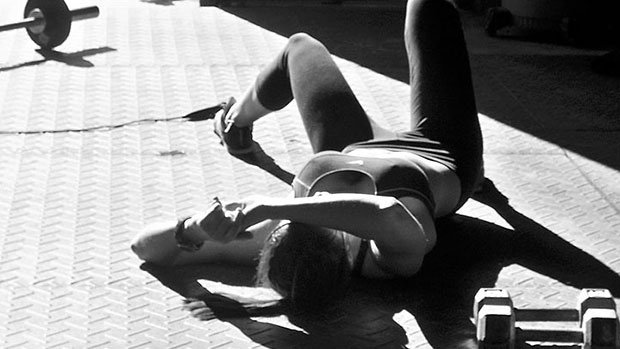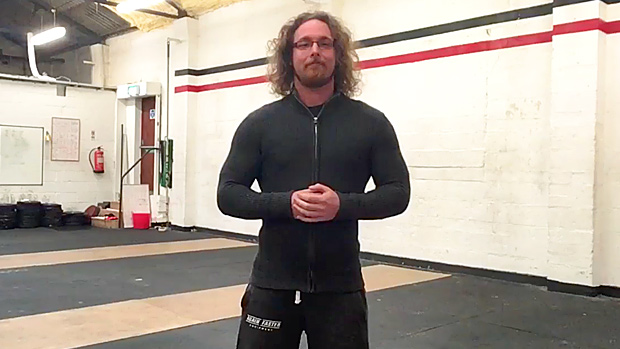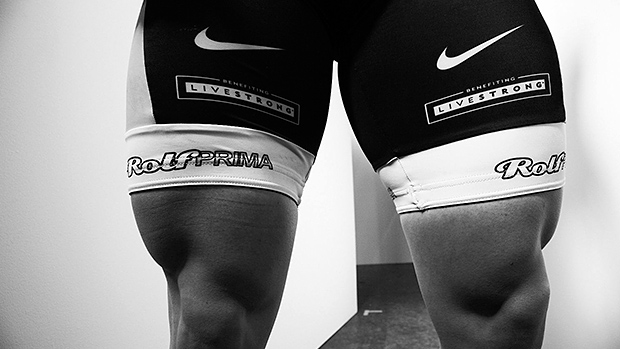More Muscle = Higher Metabolism
Whenever people decide to lose body fat, they make the same dumb mistake: They adopt strategies that make it impossible to preserve their muscle mass.
They lose weight, of course, but they lose just as much lean body mass as fat mass. They simply become smaller versions of their unaesthetic selves.
Sure, they'll occupy less space, the scale will tell them they weigh less, and their doctor might even congratulate them for being closer to their "healthy weight," but in reality they aren't looking any better, which kind of misses the point.
The number one priority when trying to lose fat should be keeping muscle. Losing muscle mass should not be acceptable. Doing so will make it harder to continue losing fat since muscle tissue is metabolically responsible for most of the fat you'll lose.
Ten pounds of muscle burns 50 calories per day even at rest, so if you lose 10 pounds of muscle, you will burn 50 fewer calories per day, or 350 fewer calories per week. That can make a significant difference in the long run.
Then there's the issue of insulin sensitivity. If you have more muscle, your insulin sensitivity will be slanted more towards accruing muscle mass. A larger muscle has more insulin receptors, which makes the muscles more insulin sensitive.
That means you'll tend to store more of what you eat in the muscles instead of as body fat. Lastly, when you have more muscle mass, you can lift more weight and train harder, which increases the amount of calories you burn during a workout.
As you can see, it's not only important to maintain muscle when dieting, it's vital. Here are the biggest mistakes people make when trying to lose fat.
Fasted cardio, most often done first thing in the morning, has been a popular approach in the world of bodybuilding for years... and it works, if you're using performance-enhancing drugs to protect your muscle mass. But for a natural lifter, fasted cardio is a very good way to eat away at your muscle mass.
First of all, cortisol is at its highest in the morning (the cortisol spike is what allows you to have energy when you wake-up). If you don't eat, it will stay elevated and even increase.
And if you couple it with cardio, which also tends to jack up cortisol output, you'll end up with a sky-high cortisol level, which is one of the best ways to lose muscle.
Not only that, if it gets high enough you'll actually have a hard time bringing it down during the day (especially when in a caloric deficit). You end up spending the whole day in a muscle-wasting state!
I'm not pro-cardio or anti-cardio. Some people need it to get super lean, some don't. I do however think that people introduce it too soon in a fat loss phase. If you decide to use cardio to get leaner, doing it fasted is a bad idea.
The absolute best way to get the greatest caloric expenditure over the whole day from cardio is to do your it in what's called the post-absorptive state. That means not in a fasted state, but not while you're still digesting either.
The post-absorptive state is when nutrients are available in the bloodstream and fat oxidation and caloric expenditure is at its greatest.
If you do your cardio in a fasted state, the overall fat oxidation over a 24-hour period is significantly lower, probably because the metabolic rate doesn't increase or stay elevated, but also because the bout of activity causes more fatigue.
You instinctively end up lowering your activity level throughout the day. There's also the issue of fasted cardio being potentially catabolic to muscle mass.
However, doing cardio after you just ate isn't better either. It'll lead to less fat oxidation and more glucose oxidation, not to mention that a lot of people have a hard time going hard on energy system work when they're still digesting a meal.
The best option is to perform cardio when the body has fully absorbed nutrients prior to the activity. Unfortunately, this is really hard to do with solid food. It's almost impossible to know how fast solid food is digested. It will vary from person to person and even from time of day in the same person.
What I use is Mag-10® because it's readily absorbed, so you can drink it and do cardio afterwards and get all the benefits of the post-absorptive state. It boosts metabolic rate and actually helps you get leaner faster.
To summarize, avoid fasted cardio when you're trying to lose fat and are not using an anabolic aid. (Mag-10 works perfectly for that purpose.) Do cardio in the post-absorptive state to preserve muscle mass and will have the greatest impact on your fat loss over a 24-hour period.

Maintaining or even gaining strength is the absolute best way to make sure that you're not losing muscle mass. If you keep pushing big weights, it'll force the body to keep its muscle since it will see it as necessary for survival.
If you reduce the amount of weight you're lifting, the body will "assume" that you don't require as much strength and that it's okay to lower your muscle mass. Why? Because muscle uses a ton of calories every day and the body will see it as expendable.
Then there is the second part of the mistake: increasing reps. Often times this is done to "cut up" a muscle. Too bad that's impossible to do.
You cannot get a muscle more cut. You can only make it bigger or smaller. To get more "cut" you need to get rid of the fat while keeping the muscle large and full.
Some people aren't stupid enough to think that lifting lighter weights for more reps works, but they still perform higher reps simply to burn more calories and accelerate fat loss.
That's fine, provided that you did your heavy lifting already. However, if you overdo the reps, you can indirectly decrease your muscle mass by impairing recovery.
When your caloric intake is reduced, your capacity to recover from training is already handicapped, so adding the burden of increased volume can lead to regression in both performance and muscle size.
The moral of the story? Do everything in your power to at least maintain your strength when dieting down, and this will not happen if you stop lifting heavy to focus on doing more pump work.
If you decide to add cardio to your fat loss regimen, you have two options and both are at opposite ends of the spectrum: low-intensity like walking, or high-intensity like sprints and HIIT.
It's a hormonal thing. Moderate intensity/steady state cardio – the type that most people are doing when trying to lose fat – will increase cortisol levels the most. The activity is just intense enough to stimulate the release of cortisol, and also long enough to elevate it significantly.
Low-intensity cardio, however, in the form of taking a one-hour walk in the park or something, will not be intense enough to stimulate much cortisol release. In fact it might actually lower cortisol levels by having a relaxing effect.
High-intensity work, on the other hand, might lead to a lot of cortisol being produced, but the duration of the activity isn't usually long enough to lead to a large elevation.
Use longer, low-intensity work (a relaxing pace at which you can sustain a conversation) for 45-60 minutes, or high-intensity work lasting 15 minutes or less.
That's why I love loaded carries. Three to five minutes is all you need to get an amazing fat burning effect with basically zero negative impact on muscle mass. In fact, it can help you build some muscle!
Losing fat and changing your body is an emotional issue; we want that dream body and we want it right now! That mindset leads to our fourth mistake: starting out way too abruptly.
I've seen people start their diet out with less than 50 grams of carbs and fat per day for a total of roughly 1200 calories. Add to that doing 90 minutes of cardio per day (sometimes 120 minutes spread into two daily sessions), doing circuit training in the gym, and using a powerful fat burner formula.
Great. But how long do you think someone can sustain that? More importantly, how long do you think it'll take the body to adapt?
The body will adapt to that level of deprivation and activity level in 4 to 6 weeks and fat loss will come to a screeching halt... and that is if you can make it 4-6 weeks! You'll feel depressed, have unbearable hunger, zero energy, and basically stop enjoying life. And then there is the muscle loss from such an excessive approach.
So what happens when fat loss stalls with this approach? What can you do to get it started again? You have nothing left to cut from your diet, and unless you can afford to devote your whole agenda to training, you can't ramp up the activity any further (you won't have the energy anyway).
You'll be doomed. You'll still lose some fat, but progress will be so slow that there is no way you'll be able to handle it long enough to reach your goal.
Avoid being excessive from the start. Use the dietary and cardio strategy to allow you to lose fat at an acceptable rate and train to maintain or increase your strength.
The more conservative you are while still getting good fat loss results, the more options you'll have to play with when fat loss slows down.

When someone wants to get ripped he naturally tends to add exercises to his program. He does that because he believes that doing so will help him "carve" the muscle by working it from as many angles as possible. Well, you cannot carve, shape, or cut a muscle. You can only make it bigger or smaller.
Adding exercises will not work for the purpose of shaping or carving a muscle.
Can you make it bigger by adding more exercises? Sure, if you're in a caloric surplus, but when in a caloric deficit your body will have a hard time just maintaining the muscle mass it already has.
Adding a significant amount of muscle will be very hard to do if you're a natural lifter. Since you won't be in a physical state conducive to building new muscle tissue, adding more exercises will only make you burn more fuel. Which, in turn, might actually make it harder to recover from your training – not something we want when trying to preserve muscle mass.
Now, some people swear that adding exercises makes their muscles larger. This is more likely due to inflammation of the muscle tissue (which will naturally tend to increase when dieting since it's harder to recover), which can make the muscles feel and even look swollen.
But that won't last long and it won't take much time to start losing your capacity to get a pump, and that's the first sign that you're about to start losing muscle. The idea is to focus on the big money lifts to maintain your strength. You correct muscle imbalances and lagging body parts when you're in a caloric surplus, not when you're dieting down.
This is probably the most common problem. I've even been guilty of it myself! For a long time carbs were thought to be the enemy of fat loss. That was especially true during the low-carb diet craze a few years back.
Nobody was as carbophobic as I was. So I understand the impulse to suddenly stop using workout carbs (before, during and post-workout) when dieting down.
But your absolute best insurance policy when it comes to preserving (and even increasing) muscle mass when dieting down is workout nutrition like Plazma™ which contains fast acting di- and tri- peptides and functional carbs.
If anything, you should increase your workout nutrient intake when dieting down, then reduce carbs and calories for the rest of the day. This will give you the maximum fat burning effect possible.
Don't be afraid of workout carbs – the highly-branched cyclodextrins in Plazma actually have fat burning effects. They won't be stored as fat, and they'll increase your rate of fat loss by allowing you to train harder and keep your metabolic rate higher.

This was popular in some bodybuilding circles when it got out that Ronnie Coleman was doing it when preparing for the Mr. Olympia.
Performance-enhancing drugs change your physiology. For example, steroids/androgens and cortisol share a cellular messenger. Without giving you a physiology lecture, it means that the more androgens you have in your body, the less impact cortisol will have on you.
Doing cardio – especially moderate steady state cardio – will elevate your cortisol, and in the natural hormonal cycle of humans, cortisol has to be at its lowest before going to bed. Having a high cortisol level when going to bed will make it much harder to go to sleep and much harder to have a restorative sleep episode.
It will also turn your sleep period into a 7 to 10 hour-long catabolic episode, which isn't a good mix if you value your muscle mass. To maintain your muscle, recover faster from your training, and optimize your hormonal levels and cycles, avoid evening/night cardio.
- Keep lifting heavy on the big basic lifts.
- Do not add extra exercises.
- Do not try to burn more calories via weight lifting.
- If you decide to do cardio, choose low-intensity cardio, high-intensity/short duration cardio, or loaded carries and make sure to be in a post-absorptive state. Also, avoid doing cardio at night.
- Do not try to correct lagging muscle groups when in a caloric deficit. The best you can do is maintain your muscle or increase it slightly; you can't make drastic changes at this point.
- Don't ditch your workout nutrition carbs. Increase them.
- Start conservatively. Do just enough to maintain a good rate of progress – a loss of 2 pounds per week, for example – so that you keep some weapons in store for when fat loss slows down.





